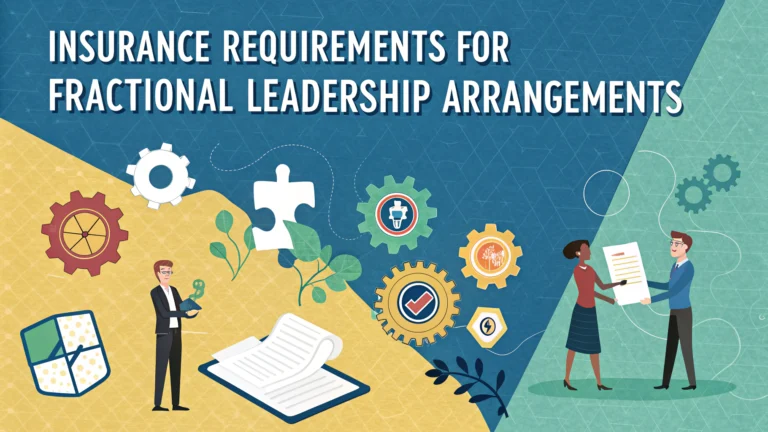Insurance coverage for fractional leadership arrangements requires careful consideration to protect both the organization and the temporary executive.
Fractional executives, particularly COOs, operate in unique risk environments that blend traditional employment and consulting relationships.
Understanding the proper insurance requirements helps organizations maintain compliance while protecting all parties involved in fractional leadership agreements.
Essential Insurance Coverage Types
- Professional Liability Insurance (E&O): Covers errors and omissions in professional services
- Directors and Officers (D&O) Insurance: Protects against management decisions
- General Liability Insurance: Covers third-party injuries and property damage
- Workers’ Compensation: Required if classified as an employee
- Cyber Liability Insurance: Protection against data breaches and cyber incidents
Coverage Limits and Considerations
Standard professional liability coverage should start at $1 million per occurrence for fractional executives.
D&O insurance typically requires minimum coverage of $2 million for small to medium-sized businesses.
| Insurance Type | Recommended Minimum Coverage |
|---|---|
| Professional Liability | $1,000,000 |
| D&O Insurance | $2,000,000 |
| General Liability | $1,000,000 |
Employment Status Impact
The classification of the fractional executive as either an independent contractor or employee affects insurance requirements.
- Independent Contractor Status:
- Must maintain own professional liability insurance
- Responsible for general liability coverage
- Should carry business insurance
- Employee Status:
- Covered under company’s workers’ compensation
- Protected by company liability policies
- May need supplemental coverage
Contract Requirements
Insurance requirements should be clearly outlined in the fractional leadership agreement.
- Specify required coverage types and minimums
- Include certificate of insurance requirements
- Define responsibility for premium payments
- Outline notification requirements for coverage changes
Risk Management Best Practices
Regular insurance audits help ensure adequate coverage as responsibilities evolve.
- Review coverage annually
- Document all executive decisions
- Maintain clear communication channels
- Keep detailed records of services provided
Next Steps for Protection
Contact a commercial insurance broker specializing in executive coverage for specific guidance.
Consider joining professional associations that offer group insurance rates for fractional executives.
Insurance providers specializing in fractional executive coverage:
– AIG Executive Liability: www.aig.com
– Chubb Executive Protection: www.chubb.com
– The Hartford: www.thehartford.com
Industry-Specific Considerations
Different industries may require specialized insurance coverage for fractional executives.
- Healthcare:
- Medical malpractice coverage considerations
- HIPAA compliance protection
- Patient data security insurance
- Financial Services:
- Fiduciary liability insurance
- Investment advisor coverage
- Financial institution bonds
- Technology:
- Enhanced cyber liability protection
- Intellectual property coverage
- Technology E&O insurance
International Coverage Requirements
Fractional executives working across borders need additional insurance considerations:
- International liability coverage
- Travel insurance for executive mobility
- Country-specific regulatory compliance
- Cross-border risk protection
Claims Process Management
Establishing clear procedures for handling potential claims is crucial:
- Document incident reporting protocols
- Maintain communication procedures with insurers
- Establish legal counsel relationships
- Create crisis management plans
Securing Your Professional Future
Comprehensive insurance coverage is essential for protecting both the organization and fractional executive’s interests. Regular review and updates of coverage ensure continued protection as business needs evolve.
- Evaluate coverage needs quarterly
- Stay informed about industry insurance trends
- Build relationships with reliable insurance providers
- Maintain detailed documentation of all coverage decisions
Remember to consult with legal and insurance professionals when establishing or modifying coverage for fractional executive arrangements.
FAQs
- What types of insurance coverage are typically required for fractional COO arrangements?
Professional Liability Insurance (E&O), General Liability Insurance, and Directors & Officers (D&O) Insurance are the primary coverages needed for fractional COO positions. - Do fractional COOs need their own insurance, or are they covered under the client company’s policies?
Fractional COOs should maintain their own professional liability insurance, as client company policies may not extend to independent contractors or consultants. - What is the typical coverage amount recommended for Professional Liability Insurance in fractional leadership roles?
Most fractional COOs carry Professional Liability coverage between $1-2 million per occurrence, with some industries requiring higher limits up to $5 million. - Does working with multiple clients require different insurance arrangements?
Yes, insurance policies should be structured to cover work with multiple clients, and some clients may require being added as additional insureds on certain policies. - How does insurance coverage differ between independent fractional COOs and those working through consulting firms?
Independent fractional COOs must secure their own coverage, while those working through consulting firms may be covered under the firm’s umbrella policy. - Are there specific insurance requirements for fractional COOs handling financial decisions?
Yes, fractional COOs making financial decisions should consider additional coverage like Crime Insurance or Fidelity Bonds, especially when handling company assets or finances. - What role does cyber liability insurance play in fractional COO arrangements?
Cyber liability insurance is increasingly important as fractional COOs often access client systems and sensitive data, requiring protection against cyber risks and data breaches. - Does working remotely as a fractional COO affect insurance requirements?
Remote work may require additional coverage considerations, particularly for cyber security and home-based business insurance. - How often should fractional COOs review and update their insurance coverage?
Insurance coverage should be reviewed annually and updated whenever there are significant changes in client portfolio, services offered, or risk exposure. - What factors affect the cost of insurance for fractional COOs?
Insurance costs are influenced by factors including industry focus, number of clients, revenue, services provided, and claims history.








